|
INDEPENDENCE National Historical Park |
 |
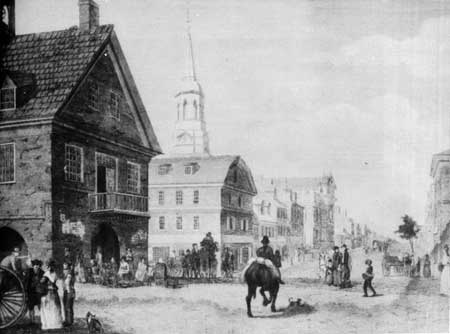
Second Street north from Market showing old City
Hall in left foreground, one of the meeting places of the Assembly until
the completion of the State House. Christ Church is in the
background.
Engraving by William Birch, 1799. Courtesy Historical
Society of Pennsylvania.
The State House and Independence
Philadelphia, the metropolis of English America, was destined to become even more prominent during the American Revolution. As opposition to England's colonial policy developed in America, the city's location near the center of colonial America naturally made it the focal point of government. The long tension between the American colonies and the mother country, which had led to occasional acts of violence in the past, again erupted in 1773 when a group of Bostonians destroyed a shipment of tea. Instead of making an effort to discover the nature of the Americans' opposition, the English Government attempted to punish them by closing the port of Boston.
The Americans promptly chose representatives to an intercolonial congress which was to become known as the First Continental Congress. This body, composed of leading citizens of the colonies, gathered on September 5, 1774, at the City Tavern before convening formally at Carpenters' Hall, a new building erected by the Carpenters' Company of Philadelphia. Reluctant to adopt a course of open defiance, the Congress sent a petition to the King asking him to restore those rights of Englishmen which Parliament seemed determined to take away. In answer to the English acts of coercion, the Congress turned to economic pressure by calling upon Americans to boycott English goods. Although the First Continental Congress protested strongly against violations of the "rights of Englishmen" claimed for the American colonists, no demand for independence was made.
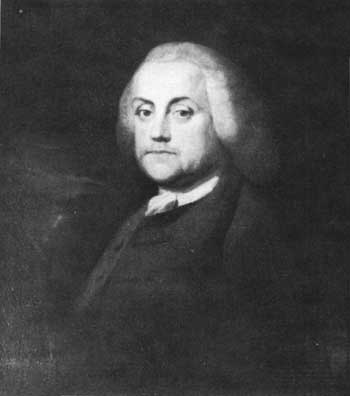
Benjamin Franklin by Benjamin Wilson, 1759. Upon
the evacuation of Philadelphia by the British, this portrait was removed
from Franklin's house by Captain Andre and carried to England. It was
returned to America in 1906 by Earl Grey and is now in the White House,
Washington, D. C.
After the first Congress adjourned on October 26, 1774, relations between the colonies and the mother country grew steadily worse. On April 19, 1775, the Minute Men of Massachusetts fought the British forces at Lexington and Concord, thus challenging the armed might of the British Empire. About a month later, on May 10, the Second Continental Congress met in an atmosphere of tension in the Assembly Room of the State House. The governing body, forced by events, moved from protest to resistance. Under the Presidency of John Hancock, the Congress (in June) chose George Washington to be General and Commander in Chief of the Army. The latter, "from his usual modesty, darted into the library-room" when his name was first suggested by John Adams. But after a unanimous election, Washington accepted that commission in the Assembly Room and left shortly thereafter to assume his most difficult duties. Despite the outbreak of warfare, this session of the Continental Congress adjourned on August 1, 1775, without a demand for independence.
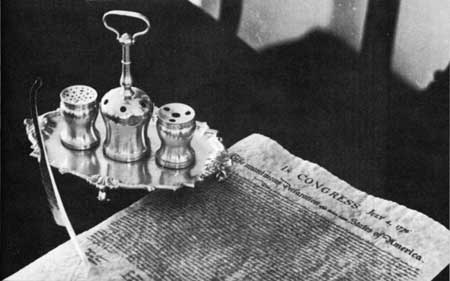
Silver inkstand, still preserved in Independence
Hall, used during the signing of the Declaration of
Independence.
When the Congress reconvened on May 10, 1775, in the State House. King George III had already issued a proclamation (August 23, 1775) declaring that "open and avowed rebellion" existed in the colonies. This and other actions of the King, as well as the publication in Philadelphia of Thomas Paine's Common Sense, caused public sentiment in favor of independence to grow rapidly in 1776. It was a difficult task, however, to overcome the reluctance of the conservative delegates to make an open break.
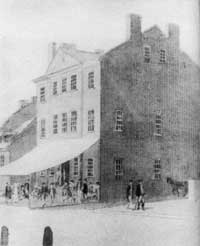 City Tavern, where the delegates to the First Continental Congress gathered, on the morning of September 5, 1774, prior to their formal assembly at nearby Carpenters' Hall. Engraving after William Birch, 1799. Courtesy Philadelphia Free Library. |
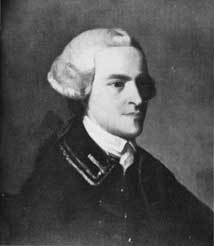 John Hancock, president of the Second Continental Congress from 1775 to 1777. Painting attributed to Charles Willson Peale, date unknown. Copy in Independence National Historical Park collection. |
Not until June 7, 1776, did Richard Henry Lee, of Virginia, acting on instructions from the Virginia Convention, offer a resolution declaring, "That these United Colonies are, and of right ought to be, free and independent States," and that foreign alliances and a plan of confederation ought to be created. Then, after 2 days of debate, consideration of the resolution was postponed for several weeks. Meanwhile, a committee, composed of Thomas Jefferson, John Adams, Benjamin Franklin, Roger Sherman, and Robert R. Livingston was named to draft a declaration "setting forth the causes which impelled us to this mighty resolution." On July 2, 1776, Lee's resolution was adopted after a heated debate in which Adams played a dominant role. Two days later, the Congress formalized this act by adopting the Declaration of Independence. On August 2, after it had been engrossed, the document was signed by most members of Congress. These drastic and irrevocable actions, in effect, marked the end of British authority in the American colonies and the birth of the United States of America.
The Declaration of Independence is one of the greatest statements of the principles of democracy ever penned. Written largely by Thomas Jefferson, it expressed the thoughts and feelings not only of the assembled delegates but also of that part of the American people bent on freedom and independence. These thoughts, expressed in the measured cadence of Jefferson's lines, gave the colonists a creed to be triumphantly established: "That to secure these rights [Life, Liberty and the pursuit of Happiness], Governments are instituted among Men, deriving their just powers from the consent of the governed." Here is the continuing principle now permanently entrenched as the heart of American democracy.
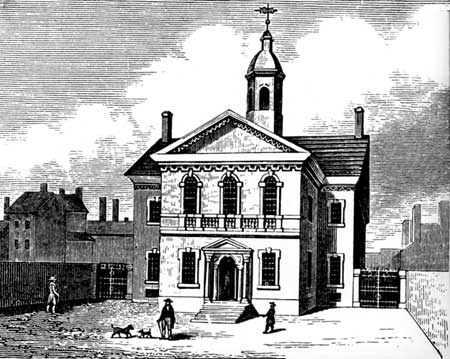
Carpenters' Hall, built by the Carpenters' Company
of Philadelphia, where the First Continental Congress met in
1774.
Courtesy Philadelphia Free Library.
To institute such a government required the agonies of a long, often indecisive and frequently discouraging war. Throughout the many and hard years of the Revolution, the Congress sat in the State House, except for periods of danger such as the occupation of Philadelphia by the British forces from September 1777 to June 1778. During that winter, Washington's small army endured untold hardships while keeping watch at Valley Forge when the American cause appeared almost hopeless.
In 1778, however, the cause received new strength. Largely through the astute diplomacy of Benjamin Franklin, an alliance was formed with France; and, on August 6, 1778, Conrad Alexandre Gerard, the first French Minister to this Nation, formally presented his credentials to Congress in the Assembly Room.
With the flow of men, money, and supplies from France, the war was brought to a virtual conclusion at Yorktown, Va., in 1781. When Washington's dispatches reporting this victory were received by the Congress in the State House, on October 24, celebrations and general rejoicing were held throughout Philadelphia. About a week later, Congress was presented with 24 stands of colors captured at Yorktown.
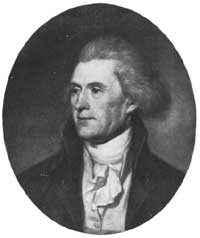 Thomas Jefferson, author of the Declaration of Independence. Painting by Charles Willson Peale (c. 1791). Independence National Historical Park collection. |
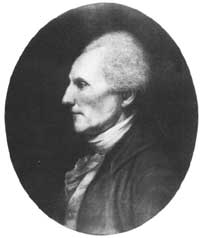 Richard Henry Lee, whose momentous resolution adopted on July 2, 1776, was, in the words of John Adams, "the greatest question . . . ever . . . debated in America, and a greater, perhaps, never was nor will be decided among men." Painting by Charles Willson Peale, 1784 Independence National Historical Park collection. |
The formation of a confederation for the new nation was an even more difficult task than obtaining agreement to the Declaration of Independence, and steps to form such a confederation were taken very early in the Revolution. As a matter of fact, only 8 days after the Declaration was adopted, a draft constitution, called the Articles of Confederation and Perpetual Union, was first reported by a committee to the Congress. In spite of the need for unity to meet the enemy's threat, the States were not willing to commit themselves to the various obligations (small though they now seem) required in the proposed confederation. Maryland, in particular, insisted that, as a condition of her acquiescence, certain other States first surrender their claims to western lands. On July 9, 1778, eight States signed the Articles of Confederation in the Pennsylvania State House. Maryland did not accede until 4 years later, after Virginia, Massachusetts, and Connecticut gave up their claims to the region which became known as the Northwest Territory. However, the new Articles of Confederation, giving the revolutionary government constitutional standing, did not begin their short period of effectiveness until March 1, 1781.
This first frame of government did not attempt to form a powerful national government; under the Articles of Confederation the States retained almost the power of independent nations. However, the Articles did create a Congress which could consider and legislate matters affecting the Nation as a whole. Although they contained certain weaknesses, they held together the 13 States long enough for responsible leaders to discover the kind of government the United States must have.
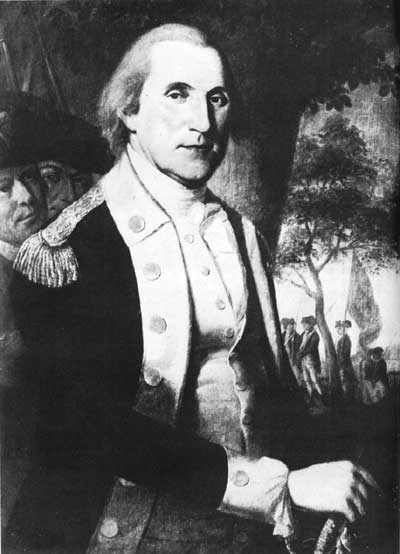
George Washington.
Painting by James Peale
(c. 1787). Independence National Historical Park
collection.
During those critical years, the State House had served the new nation well as a capitol. As already noted, it was in this building that Congress had organized the national administration and made the necessary plans for carrying the war through to its successful conclusion. The Provincial Assembly of Pennsylvania, meanwhile, having graciously relinquished its accustomed room to Congress, had carried on as best it could in a crowded space on the second floor of the State House.
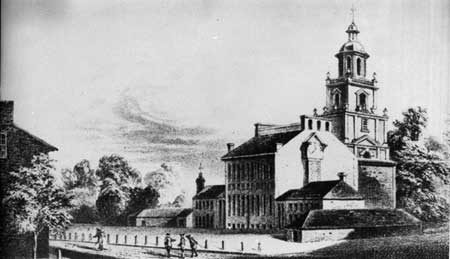
State House as it appeared about 1776.
Lithograph based on detail from painting by Charles Willson Peale (c.
1779). Courtesy Philadelphia Free Library.
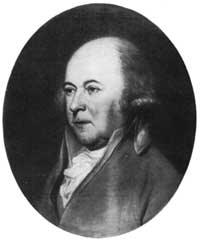 John Adams, one of the most active members of the Continental Congress, and the "ablest advocate and defender" of the Declaration of Independence, played a major role in the achievement of independence. Painting by Charles Willson Peale, before 1795. Independence National Historical Park collection. |
The occupation of Philadelphia by the British had been a period of distress not only for the American cause but for the State House as well. The building had first been 'used as quarters for British troops. After the battle of Germantown, it served as a hospital for wounded American soldiers.
These uses of the building had left it, in the words of a member of the Congress, in "a most filthy and sordid situation," with "the inside torn much to pieces." Extensive cleaning and repairs were required to refit the building for meetings of the State Government and the Congress. The Assembly took advantage of this need for repairs to enlarge their temporary quarters in the southeast corner of the upper floor. This was done by removing the partition between their chamber and the "long room." The new space then became approximately the same size as the Assembly Room on the first floor.
The Revolutionary period also saw an alteration on the exterior of the State House—the removal of the badly decayed wooden steeple above the brick tower. The Assembly considered this step as early as 1773, but the project was not carried out until 1781. After the steeple was removed, the brick tower was covered with a low, sloping, hipped roof, surmounted by a slender finial.
In 1783, a body of mutinous soldiers surrounded the State House and demanded back pay from Congress. Although the members of Congress were unharmed, the incident led to their moving to Princeton. The Congress of the Confederation never returned to the State House.

|

| History | Links to the Past | National Park Service | Search | Contact |
|
Last Modified: Mon, Dec 2 2002 10:00:00 am PDT |

